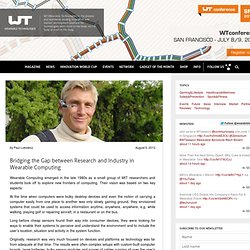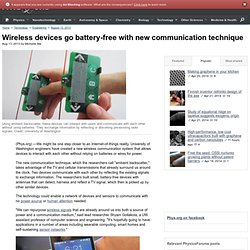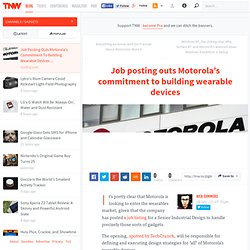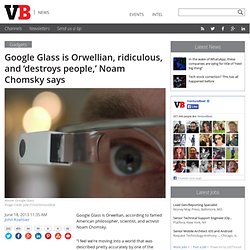

Bridging the Gap between Research and Industry in Wearable Computing. Wearable Computing emerged in the late 1980s as a small group of MIT researchers and students took off to explore new frontiers of computing.

Their vision was based on two key aspects: At the time when computers were bulky desktop devices and even the notion of carrying a computer easily from one place to another was only slowly gaining ground, they envisioned systems that could be used to access information anytime, anywhere, anywhere, e.g. while walking, playing golf or repairing aircraft, in a restaurant or on the bus. Long before cheap sensors found their way into consumer devices, they were looking for ways to enable their systems to perceive and understand the environment and to include the user’s location, situation and activity in the system function.
New Tab. Inside peek at Accenture Labs: Google Glass, Big Oil. Vicki Thompson Accenture CTO Paul Daugherty models Google Glass at Accenture Technology Labs in San Jose.
Click above to see inside the lab. Mpico Plans to Bring Wireless E-ink Screens to Smart Cards & ePaper Labels, Could Beat Amazon to Market. E-ink got a lot of press the week before last with the announcement of a couple new shelf label systems, but they’re not the only ones taking this screen tech to places you would not expect.

While I was in Vancouver for SID Display Week I spent a few minutes with Peter Slikkerveer of Mpico. He was showing off the prototype for a new epaper label system that could potentially replace smart cards and luggage labels. These new labels are wireless, battery-less, and have a screen which can be updated remotely. I met the Mpico rep at the Innovation Zone, an area set aside for single table demos. Geode – eInk and Transmorphing Credit Card in an iPhone Case. Wireless devices go battery-free with new communication technique. (Phys.org) —We might be one step closer to an Internet-of-things reality.

University of Washington engineers have created a new wireless communication system that allows devices to interact with each other without relying on batteries or wires for power. The new communication technique, which the researchers call "ambient backscatter," takes advantage of the TV and cellular transmissions that already surround us around the clock.
Two devices communicate with each other by reflecting the existing signals to exchange information. The researchers built small, battery-free devices with antennas that can detect, harness and reflect a TV signal, which then is picked up by other similar devices. The technology could enable a network of devices and sensors to communicate with no power source or human attention needed. "Our devices form a network out of thin air," said co-author Joshua Smith, a UW associate professor of computer science and engineering and of electrical engineering. Frog Design and Motorola unveil a new family of wearable devices. Job posting outs Motorola’s commitment to building wearable devices. It’s pretty clear that Motorola is looking to enter the wearables market, given that the company has posted a job listing for a Senior Industrial Design to handle precisely those sorts of gadgets.

The opening, spotted by TechCrunch, will be responsible for defining and executing design strategies for “all” of Motorola’s wearable devices. “The Industrial Design Team collaborates closely with our internal work partners to create compelling, usable and innovative products that define our brand with over a million consumers worldwide,” the listing reads. “The wearables design team will lead the establishment of our brand in the massive competitive and growing space of wearable connected products.” How Wearable Technology Is Transforming Facilities. Mobile devices are necessary tools to increase the efficiency and productivity of workers across many industries and markets, including the warehouse.

But wearable, voice-directed and multimodal mobile technologies are helping to transform the warehouse environment at an even faster pace than standard mobile tools in other markets. Wearable and voice-directed technology can build off of existing tools already in your warehouses and provide performance improvement above and beyond what was realized with the first waves of mobile investments more than a decade ago.
This technology keeps workers’ eyes on the task at hand and their hands free, automating tasks, streamlining processes, improving worker safety, and improving overall warehouse performance levels. Google Glass is Orwellian, ridiculous, and ‘destroys people,’ Noam Chomsky says. Google Glass is Orwellian, according to famed American philosopher, scientist, and activist Noam Chomsky.

“I feel we’re moving into a world that was described pretty accurately by one of the founders of Google,” Chomsky said. A Wearable Computer More Powerful than Glass, and Even More Awkward. Steve Mann, a pioneer in the field of wearable computing, has been touting the benefits of head-mounted computers for decades.

Now the University of Toronto professor is also lending his weight and experience to a company hoping to loosen Google Glass’s grip on the nascent market with a different take on computer glasses that merges the real and the virtual. The company, Meta, is building computerized headwear that can overlay interactive 3-D content onto the real world. VIDEO: Transparent, Stretchy Speaker Shows ‘Soft Machine’ Potential. Dell eyes wearable computing move as PC business keeps slumping. Struggling computer maker Dell is considering a move into the "wearable computing" space, as it grapples with the effects of a shrinking PC market.

Sam Burd, Dell's global vice-president of personal computing, told the Guardian that "we're exploring ideas in that space".